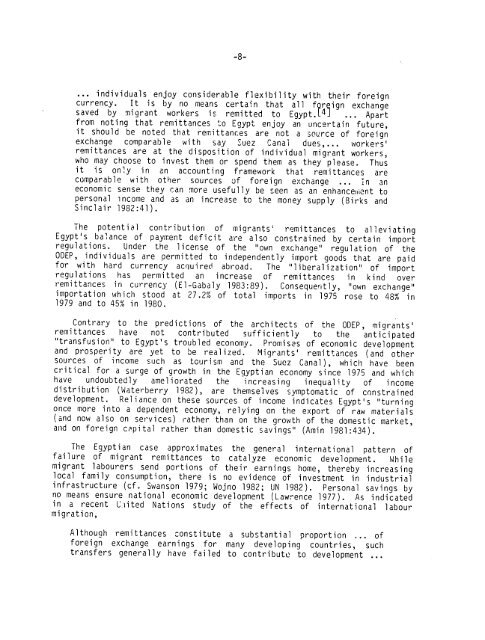FAMILIAL ADAPTATIONS TO THE INTERNATIONALIZATION OF ...
FAMILIAL ADAPTATIONS TO THE INTERNATIONALIZATION OF ...
FAMILIAL ADAPTATIONS TO THE INTERNATIONALIZATION OF ...
You also want an ePaper? Increase the reach of your titles
YUMPU automatically turns print PDFs into web optimized ePapers that Google loves.
-8<br />
individuals enjoy considerable flexibility with their foreign<br />
currency. It is by no means certain that all fQreign exchange<br />
saved by migrant workers is remitted to Egypt.L 4 ] ... Apart<br />
from noting that remittances to Egypt enjoy an uncertain future,<br />
it should be noted that remittances are not a source of foreign<br />
exchange comparable with say Suez Canal dues,.., workers'<br />
remittances are at the disposition of individual migrant workers,<br />
who may choose to invest them or spend them as they please. Thus<br />
it is only in an accounting framework that remittances are<br />
comparable with other sources of foreign exchange ... in an<br />
economic sense they can more usefully be seen as an enhance, ent to<br />
personal income and as an increase to the money supply (Birks and<br />
Sinclair 1982:41).<br />
The potential contribution of migrants' remittances to alleviating<br />
Egypt's balance of payment deficit are also constrained by certain import<br />
regulations. Under the license of the "own exchange" regulation of the<br />
ODEP, individuals are permitted to independently import goods that are paid<br />
for with hard currency acquired abroad. The "liberalization" of import<br />
regulations has permitted an increase of remittances in kind over<br />
remittances in currency (El-Gabaly 1983:89). Consequently, "own exchange"<br />
importation which stood at 27.2% of total imports in 1975 rose to 48% in<br />
1979 and to 45% in 1980.<br />
Contrary to the predictions of the architects of the ODEP, migrants'<br />
remittances have not contributed sufficiently to the anticipated<br />
"transfusion" to Egypt's troubled economy. Promises of economic development<br />
and prosperity sources are of yet income to be such realized.<br />
as tourism Migrants' the remittances Suez Canal), (and other<br />
and<br />
which <br />
critical for a surge of growth in the have Egyptian been<br />
economy since 1975 and which<br />
have undoubtedly ameliorated the increasing inequality of income<br />
distribution (Waterberry 1982), are themselves symptomatic of constrained<br />
development. Reliance on these sources of income indicates Egypt's "turning<br />
once more into a dependent economy, relying on the export of raw materials<br />
(and now also on services) rather than on the growth of the domestic market,<br />
and on foreign capital rather than domestic savings" (Amin 1981:434).<br />
The Egyptian case approximates the general international pattern of<br />
failure of migrant remittances to catalyze economic development. While<br />
migrant labourers send portions of their earnings home, thereby increasing<br />
local family consumption, there is no evidence of investment in industrial<br />
infrastructure (cf. Swanson 1979; Wojno 1982; UN 1982). Personal savings by<br />
no means ensure national economic development (Lawrence 1977). As indicated<br />
in a recent Utiited Nations study of the effects of international labour<br />
migration,<br />
Although remittances constitute a substantial proportion ... of<br />
foreign exchange earnings for many developing countries, such<br />
transfers generally have failed to contribute to development ...
















